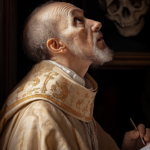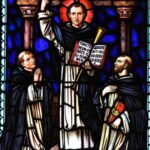St. Jerome
St. Jerome
St. Jerome: The Unconventional Scholar of His Time
When they lived:
St. Jerome, the enigmatic scholar and translator, lived during the late 4th and early 5th centuries AD. Born around 347 AD in the town of Stridon, near the border of modern-day Croatia and Slovenia, he spent a significant part of his life traveling and residing in various parts of the Roman Empire.
Where they lived:
Though Jerome’s birthplace was Stridon, he later settled in Rome, where he experienced a vibrant intellectual atmosphere. However, his thirst for knowledge and spiritual growth took him on a remarkable journey through the Middle East. Jerome eventually found his sanctuary in Bethlehem, where he established a monastery, and this holy land became his final resting place.
Notable world events during the time of their life:
- Fall of the Western Roman Empire (476 AD): Witnessing the decline and fall of the mighty Roman Empire had a profound impact on Jerome’s life and work. Amidst the chaos and uncertainty, he sought solace in scholarly pursuits, dedicating himself to translating religious texts.
- The Council of Nicaea (325 AD): This significant ecumenical council took place before Jerome’s time but left an indelible mark on Christianity. Its doctrines and decisions influenced Jerome’s interpretation of the Bible and his role as a theologian.
- The Sack of Rome by Visigoths (410 AD): The sack of Rome was a devastating event that shocked the Roman world. This tragedy likely fueled Jerome’s inclination to find spiritual meaning and consolation amidst the turmoil of the times.
- The Great Persecution (303-311 AD): During this period, Christians faced severe persecution under Emperor Diocletian. Jerome’s faith was deeply influenced by the courage and resilience of those who stood firm in their beliefs, even in the face of adversity.
- The Founding of Constantinople (330 AD): Emperor Constantine’s establishment of Constantinople as the new capital of the Roman Empire brought about significant cultural and political changes. This event marked the beginning of a new era and prompted discussions about Christianity’s role in shaping the world.
- The Life of Augustine of Hippo (354-430 AD): The life and works of Augustine, one of Christianity’s most influential theologians and philosophers, overlapped with Jerome’s. The two scholars engaged in spirited intellectual debates, shaping the theological landscape of their time.
Their patronage:
St. Jerome is revered as the patron saint of scholars, librarians, and translators. His intense dedication to studying, preserving, and translating the sacred texts of the Bible earned him this esteemed role. Through his enduring translations, such as the Vulgate, Jerome left an everlasting legacy that enriched religious scholarship and cultural exchange for centuries to come.
St. Jerome’s intriguing personality, his passion for knowledge, and his spiritual journey in a world marred by upheaval make him an iconic figure in both the history of Christianity and the broader tapestry of human civilization. His commitment to bridging cultures through his translations and interpretations of the Bible continues to inspire generations of scholars and seekers of wisdom.
A Misspent Youth
Before he became known as St. Jerome, he was named Eusebius Sophronius Hieronymus. It was said that Jerome was born around 342 in Stridon, a part of Dalmatia. He was born into a rich but pagan family.
He was educated by Aelius Donatus, a famous Roman grammarian of his time. The young Jerome learned from him Latin and Greek. Not much is known about Jerome’s childhood other than that his parents were probably well-to-do. However, despite the efforts to raise him properly, Jerome lived a wild and misspent youth.
Around the age of 12 or so, Jerome traveled to Rome and studied grammar, rhetoric, and philosophy. He may have considered a career in law because of his training in rhetoric. However, Jerome fell into a life of misbehavior. While he was not studying, he pursued pleasure.
Living in Solitude
Fortunately, Jerome had Bonosus, his companion, who was a Christian influence. Jerome was persuaded by his influence to become a Christian and change his ways for the better. Around the year 366, Jerome was baptized by Pope Liberius.
From then on, Jerome became more interested in the study of theology. Since he began his study of theology, he has had a true conversion and sees the faith as integral to his life. In 370, he traveled to a monastery in Aquileia. There, he developed his skills as a translator, which he developed during his visits to the catacombs, translating the inscriptions on the tombs.
After his stay in Aquileia, Jerome traveled to Gaul, where he started to translate books for his personal use and collect them for his personal library. After this, he returned to Aquileia in 373. After an argument with his companion, Bonosus, the two decided to part ways. Jerome traveled eastward and reached Antioch in 374, where he became a monk.
Needing isolation for his study of the Scriptures, Jerome lived for four years as a hermit in the Syrian deserts. After this, conflicts started within the church at Antioch. He was summoned by the church officials there, as well as Pope Damasus, and they wanted him to be ordained. He did not want to become a priest, preferring instead to be a hermit or a monk. However, he offered them certain conditions, like that he would not be expected to serve in any ministry and that he would still pursue his monastic life. Subsequently, he was ordained.
Translating the Scriptures
Jerome traveled to Constantinople and studied under the great theologian St. Gregory of Nazianzus. When St. Gregory left in 382, Jerome traveled to Rome for a council of the Church. He met Pope Damasus and made him his secretary. While he was serving as secretary, Jerome promoted the ascetic way of life to everyone around him.
After Pope Damasus died in 384, Jerome became a subject of criticism and controversy. Many prominent pagans and even fellow Christians attacked him with vicious rumors. Eventually, he decided to leave Rome and arrived in Antioch in 386. There, he remained in solitude and continued his work. After a while, Jerome and a group of followers traveled to the Holy Land and had a monastery built in Bethlehem, which included dormitories for women. He spent the last years of his life there.
Jerome’s most famous work was his translation of the Bible. He translated most of the Old Testament from Hebrew and some from Greek. He also wrote scriptural commentaries, biographies, and a history of writers, and they corresponded greatly. He also held conferences, taught the young, and preached. Jerome died on September 30, 420. He was buried under the Church of the Nativity. His remains were later transferred to Rome. His feast day is September 30.
Five Interesting Facts About St. Jerome
- St. Jerome is the patron saint of archaeologists, biblical scholars, librarians, students, and translators.
- In Christian art, St. Jerome is often depicted with a lion beside him. A story recounts that while he was in solitude in the Syrian deserts, Jerome was reported to have drawn a thorn from a lion’s paw. The lion stayed loyally by his side for years.
- Because of his wayward life, even though he was not a Christian at the time, St. Jerome would visit the catacombs in Rome every Sunday and imagine himself in hell. This was to alleviate his feelings of guilt after he sinned.
- St. Jerome was a hot-tempered man. He had many people he argued with, one of whom was St. Augustine of Hippo. Eventually, they restored their relationship and began to correspond as friends and colleagues.
- One of the rumors hurled at St. Jerome was that he was having an inappropriate affair with a widow named Paula, who was one of his students in asceticism. St. Jerome provided counseling and instruction to her and became a lifelong friend and follower.
Prayer to St. Jerome
O God, who gave the Priest Saint Jeromea a living and tender love for Sacred Scripture, grant that your people may be ever more fruitfully nourished by your Word and find in it the fount of life. Through our Lord Jesus Christ, your Son, who lives and reigns with you in the unity of the Holy Spirit, one God, for ever and ever Amen.



